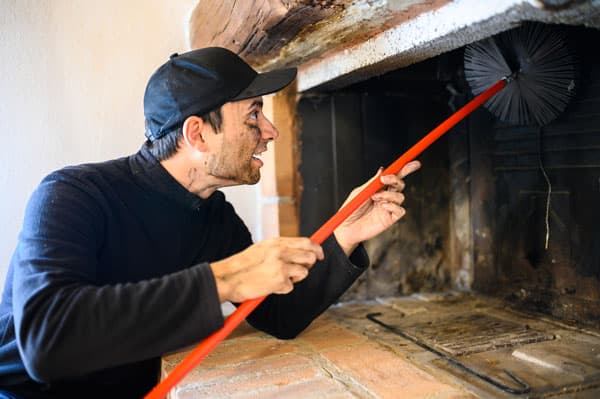

Level 1 Inspections & Chimney Sweep
The most common fireplace inspection is a Level 1. When you think you need your chimney cleaned and examined because it’s been a minute since the last time a professional has taken a good look, a Level 1 inspection is the minimum requirement.Here’s when to schedule a Level 1 chimney inspection:
- Nothing’s changed: your systems, both the appliance and venting systems, have all stayed the same. It’s the same systems you’ve used in the past and there have been no updates.
- Continued use: if you’re like most homeowners, the fireplace was why you were attracted to your house. You probably use it. Even if you don’t use it a lot, you still need to get it cleaned and checked out, and that’s what a Level 1 does.
How it works:
 For a Level 1 inspection, you’ll set up a time and date for a chimney technician to come out and examine and clean your chimney. Beforehand, you’ll need to do a little prep work. This entails moving things off of the fireplace mantle and away from the area the technician will be inspecting. So, move off picture frames, knick-knacks, fireplace tools, furniture, and anything else that will be an obstacle or you’re worried will break. Clean out the fireplace, too. Remove logs, burnt wood, ashes, and soot. When your fireplace technician arrives at the time of the scheduled appointment, they’ll place a tarp down at the worksite, so you won’t need to worry about them tracking soot through your living space. The chimney sweep will examine accessible portions of your chimney. They’ll clean your chimney as well, making sure the interior is free of the dangerous combustion by-products that buildup along the walls from fireplace usage. Tools used during a Level 1 include a specialized vacuum with flexible brush head attachment that cleans the interior of the chimney flue. This vacuum ensures that soot and ash don’t go flying everywhere and instead makes for a contained cleaning. At the conclusion of a Level 1 inspection, the chimney sweep will confirm that the chimney is clear of combustion deposits and whether the chimney is free of obstructions. You’ll be notified if the technician spots any damage or signs of concern, and if that’s the case, you’ll need to seek out a Level 2 inspection on their advice.
For a Level 1 inspection, you’ll set up a time and date for a chimney technician to come out and examine and clean your chimney. Beforehand, you’ll need to do a little prep work. This entails moving things off of the fireplace mantle and away from the area the technician will be inspecting. So, move off picture frames, knick-knacks, fireplace tools, furniture, and anything else that will be an obstacle or you’re worried will break. Clean out the fireplace, too. Remove logs, burnt wood, ashes, and soot. When your fireplace technician arrives at the time of the scheduled appointment, they’ll place a tarp down at the worksite, so you won’t need to worry about them tracking soot through your living space. The chimney sweep will examine accessible portions of your chimney. They’ll clean your chimney as well, making sure the interior is free of the dangerous combustion by-products that buildup along the walls from fireplace usage. Tools used during a Level 1 include a specialized vacuum with flexible brush head attachment that cleans the interior of the chimney flue. This vacuum ensures that soot and ash don’t go flying everywhere and instead makes for a contained cleaning. At the conclusion of a Level 1 inspection, the chimney sweep will confirm that the chimney is clear of combustion deposits and whether the chimney is free of obstructions. You’ll be notified if the technician spots any damage or signs of concern, and if that’s the case, you’ll need to seek out a Level 2 inspection on their advice.Level 2 Inspections
There are instances when you’ll need a Level 2 inspection for your chimney. A few are:- Something has changed: did you make any changes or updates to your venting system? This includes a change in the fuel you use, the flue’s liner—material or shape—or if you’ve replaced an appliance that has a different input rating or efficiency level. If so, you’ll need a Level 2 inspection.
- You’re required by purchase or sale of a property: a Level 2 inspection is required upon “the sale or transfer of a property,” according to the Chimney Safety Institute of America (CSIA). As a seller, this protects you from a buyer saying that the chimney is damaged when an inspection could say otherwise, while also getting your home ready to sell and meet all requirements. As a buyer, this protects you from costly repairs and understanding the integrity of the home in an inspection.
- The chimney has suffered damage: the most important need for a Level 2 is when the chimney has suffered damage. Damage could be caused by a chimney fire, natural disaster, or a general building fire.
How it works:
It’s easier to understand what a Level 2 inspection involves by going through what won’t happen:- Nothing will be demolished in order to conduct a Level 2 or gain access to the chimney, any doors, coverings, or panels.
- No permanently attached portions of the chimney or your home’s building structure or its finish will be removed or demolished either.
- No specialty tools, other than the video scanning equipment, are required to perform a Level 2 inspection. If specialty tools are required to say, access hidden, concealed, or hard-to-reach areas of the chimney or flue, then it becomes a Level 3 inspection.
